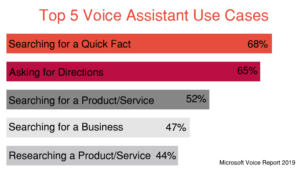
Sales of in-home voice assistants are surging. According to a report by Market Research Future, the market for this technology is anticipated to achieve revenues worth USD 7.8 billion by 2023 while growing at 39.27 percent of CAGR in the forecast period. Reasons for this growth include:
- Increased overall awareness and a higher level of comfort talking to computers
- Deep desire to optimize speed, efficiency, and convenience
- Mass adoption of artificial intelligence in consumers’ everyday lives
- Popularity of IOT devices like smart thermostats, appliances and speakers
- Ability to simplify unpopular everyday tasks
Voice assistants include Amazon’s Alexa, Samsung’s Bixby, Microsoft’s Cortana, Google Assistant and Apple’s HomePod, among others. They come with a set of built-in capabilities that can be added to by developers through custom apps to support interaction with your specific business. These developers define:
- Requests that the application can handle
- Vocabulary required from the end user to make the request
- Invocation names for a smart home device to recognize a task
Many have voice recognition capabilities and can answer questions and execute on requests. Artificial Intelligence (AI) allows them to grow ever-more efficient over time by learning from your behavior.
The Utility Business Case
For utility companies, the business case for adding in-home voice assistants to customer experience roadmaps is compelling. Because self-service continues to grow in popularity, they provide an opportunity to reduce call center costs and increase customer satisfaction. Moreover, voice assistants have the potential of becoming a new sales channel for utilities interested in selling non-traditional services like home warranties and home energy devices, all while allowing you to gather valuable behavioral data about their customers. The Microsoft Voice Report 2019 showed that 52% of voice assistant users search for a product or service, and 44% research a product or service, showing the potential, as shown in Figure 1.

Figure 1. Voice Assistant Use Cases. Via Microsoft Voice Report 2019
By simply talking into handheld devices, computers and smart speakers, your customers can get answers to questions like:
- “When should I run my dishwasher to get the best rate?”
- “How much do I owe my utility company?”
- “How can I lower my water bill?”
Custom apps can also enable voice assistants them to speak to other devices, including websites and home energy management tools to perform more actions with voice-activated control and access third-party offerings. They allow utilities to send proactive notifications and enable customers to make payments.
With all of these opportunities, voice assistants are being coined It is being coined “the new, better mobile experience.”
Developing Your Voice Assistant Strategy
Risks of not adopting a voice assistant strategy include failing to meet customer expectations. “With nearly 20% of American adults already adopting these platforms, organizations without a voice strategy are already being left behind,” said the Michael Fitzpatrick president of PullString, a computer conversation company, in 2018.
For the reasons mentioned above, utilities need to move towards building a voice assistant strategy sooner rather than later but may not know where to start.
During early discussions, a good exercise includes gathering around a conference room table and assigning one person to be the voice of the interface and a group of your customer experience professionals to represent your customers. They should consider customer pain points, why they reach out to your contact center, and new opportunities that voice assistants can support by answering questions like:
- “How could my customers interact with my brand through voice?”
- “What could they ask my product?”
- “How can I improve their experience?”
By performing this exercise, you may realize that your current static content might not be suitable if your customers are going to interact with your brand in a conversational manner. Since it’s a two-way exchange, your content will likely need to be adapted for this channel.
Of course, this is only a start. Talking to real customers and utilities that are early adopters of voice will help you move from assumptions to real needs.
Moving from Concept to Action
Once you define what you want the voice assistant to be able to do, you need to start thinking about how they will do it and who you need to partner with to move forward.
Indina Michigan Power (I&M), an American Electric Power company announced in October 2018 that it is partnering with Tendril and Google to provide voice-activated energy information and notifications to utility customers via the Google Assistant and Google Home devices.
Through the Tendril Platform, I&M will be able to combine utility customer usage and billing information with thousands of data points on each home and its occupants and provide feedback about energy usage and notifications.
In its initial roll out, the Google Assistant it will be able to answer questions such as:
- “What’s my bill amount?
- “How can I reduce my energy consumption?”
- “How is my home using energy?”
A Decision Point
From reduced call center costs and better customer data to increased customer satisfaction and the ability to add a new, innovative self-service channel, voice assistants provide a tremendous opportunity for utilities to up their game.
The question that business leaders need to ask themselves if they want to be one of the companies that embraces this channel, one that is expected to grow at a rate of 39.27% by 2023 with or without them. If the answer is yes, they will need to move quickly towards developing a voice strategy that includes defining what they want an assistant to be able to do and engaging with vendor partners who have expertise executing on the vision of “the new, better mobile experience.”















